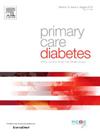土耳其糖尿病前期患者的神经病变频率及预测参数。
IF 2.6
4区 医学
Q3 ENDOCRINOLOGY & METABOLISM
引用次数: 0
摘要
简介:糖尿病感觉运动周围神经病变使患者在不知不觉中产生足部损伤。这种情况可能发展为糖尿病足溃疡;感染包括骨髓炎和下肢截肢。管理糖尿病和筛查糖尿病性神经病变对于降低患者死亡率、生活质量、功能和医疗系统并发症的成本负担至关重要。我们的目标是通过比较可以早期预测神经病变的诊断方法和检查参数来贡献文献。材料与方法:纳入神经病变评分为Douleur Neuropathique-4 (DN-4) 4分以上的患者108例,已知糖尿病患者54例,前驱糖尿病患者54例。对108例患者进行空腹血糖、口服糖耐量试验、血红蛋白A1c (HbA1c)、低密度脂蛋白胆固醇、高密度脂蛋白胆固醇、甘油三酯、尿酸、维生素B12、叶酸、肌酐和全尿分析。之后,由神经科医生进行单丝试验、音叉试验和肌电图来证实神经病变。结果:前驱糖尿病组神经病变发生率为0.40 ± 0.49 %。糖尿病性神经病变的发生率为0.71 ± 0.45 %。糖尿病前期组神经病变评分(DN-4评分)为5.1 ± 0.9,音叉试验阳性为0.18 ± 0.39,p = 0.001与糖尿病组比较差异有统计学意义(p = 0.001)。此外,在单丝试验中,糖尿病前期组的神经病变率为0.68 ± 0.47 (p = 0.027),具有统计学意义。总胆固醇(185.1 ± 21.8,p = 0.003),高尿酸(5.11 ± 1.27,p = 0.003),和低叶酸(4.5 ± 1.05,p = 0.026)发现糖尿病和前驱糖尿病的团体之间的统计学意义。讨论与结论:在神经病变的诊断中,单丝试验和双丝试验可用于临床,并已被发现是诊断神经病变的成功试验。此外,我们的分析表明低叶酸,高总胆固醇/尿酸水平和糖尿病前期神经病变之间的关系。药物干预这些因子的血液水平在预防神经病变中的作用尚不清楚。我们建议进一步调查所有患者的饮食习惯,以发现可能的危险因素,同时更谨慎地调查低叶酸和高总胆固醇/尿酸水平的患者。建议:糖尿病前期和糖尿病患者应筛查神经病变,并定期评估可能的危险因素。本文章由计算机程序翻译,如有差异,请以英文原文为准。
The frequency of neuropathy and predictive parameters in prediabetic cases from Turkiye
Introduction
Diabetic sensorimotor peripheral neuropathy causes patients to have foot injuries without realizing it. This condition may progress to diabetic foot ulcer; infections can include osteomyelitis and lower limb amputations. Managing diabetes and screening diabetic neuropathy is crucial to reducing patient mortality, quality of life, functionality, and the cost burden of complications to the healthcare system. We aim to contribute to the literature by comparing diagnostic methods and examining parameters that can predict neuropathy early.
Material and methods
A total of 108 patients with a neuropathy score Douleur Neuropathique-4 (DN-4) above 4, 54 with known diabetes, and 54 with prediabetes were included. Fasting plasma glucose, oral glucose tolerance test, hemoglobin A1c (HbA1c), LDL-cholesterol, HDL-cholesterol, triglyceride, uric acid, vitamin B12, folic acid, creatinine, and complete urinalysis was performed on 108 patients included. Afterward, a monofilament test, tuning fork test, and electromyography were performed by the neurologist to prove neuropathy.
Results
The frequency of neuropathy in the prediabetes group was found to be 0.40 ± 0.49 % using EMG. This rate is 0.71 ± 0.45 % for diabetic neuropathy. The difference is statistically significant (p = 0.001) in the prediabetic group, the neuropathy score (DN-4 score) was 5.1 ± 0.9, the tuning fork test positivity was 0.18 ± 0.39, and p = 0.001 was statistically significant compared to the diabetic group. Also, in the monofilament test, the rate of neuropathy in the prediabetes group was again statistically significant with 0.68 ± 0.47 (p = 0.027). Total cholesterol (185.1 ± 21.8, p = 0.003), high uric acid (5.11 ± 1.27, p = 0.003), and low folic acid (4.5 ± 1.05, p = 0.026) are found to be statistically significant between diabetic and prediabetic groups.
Discussion and conclusion
In diagnosing neuropathy, monofilament, and diapason testing can be used in the clinical setting, and they have been found to be successful tests in the diagnosis of neuropathy. Also, our analysis indicates the relationship between low folic acid, high total cholesterol/uric acid levels, and prediabetic neuropathy. The role of intervening blood levels of those factors with medications in preventing neuropathy is unclear. We recommend further investigating all the patient’s dietary habits to find possible risk factors, as well as investigating patients with low folic acid and high total cholesterol/ uric acid levels much more cautiously.
Recommendation
Neuropathy should be screened in prediabetic and diabetic patients, and possible risk factors should be assessed periodically.
求助全文
通过发布文献求助,成功后即可免费获取论文全文。
去求助
来源期刊

Primary Care Diabetes
ENDOCRINOLOGY & METABOLISM-PRIMARY HEALTH CARE
CiteScore
5.00
自引率
3.40%
发文量
134
审稿时长
47 days
期刊介绍:
The journal publishes original research articles and high quality reviews in the fields of clinical care, diabetes education, nutrition, health services, psychosocial research and epidemiology and other areas as far as is relevant for diabetology in a primary-care setting. The purpose of the journal is to encourage interdisciplinary research and discussion between all those who are involved in primary diabetes care on an international level. The Journal also publishes news and articles concerning the policies and activities of Primary Care Diabetes Europe and reflects the society''s aim of improving the care for people with diabetes mellitus within the primary-care setting.
 求助内容:
求助内容: 应助结果提醒方式:
应助结果提醒方式:


